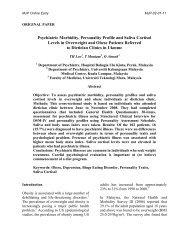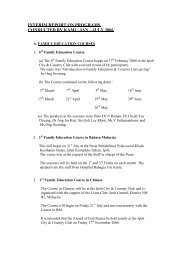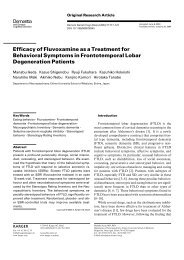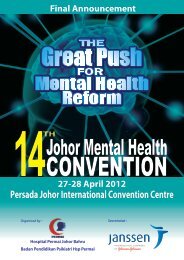Validation of Malay Version of Children Depression Inventory (CDI ...
Validation of Malay Version of Children Depression Inventory (CDI ...
Validation of Malay Version of Children Depression Inventory (CDI ...
Create successful ePaper yourself
Turn your PDF publications into a flip-book with our unique Google optimized e-Paper software.
VALIDATION OF THE MALAY VERSION OF CHILDRENDEPRESSION INVENTORY (<strong>CDI</strong>) AMONG CHILDRENAND ADOLESCENTS ATTENDING OUTPATIENTCLINICS IN KOTA BHARU, KELANTAN.MY Rosliwati* MMed; H Rohayah** MMed; BYM Jamil** MMed, M.Sc;S Zaharah*** MComMed.________________________________________________________________________ABSTRACTThe aim <strong>of</strong> this study is to validate the <strong>Malay</strong> version <strong>of</strong> <strong>CDI</strong> amongchildren and adolescents attending outpatient clinics at UniversitiSains <strong>Malay</strong>sia Hospital (USM), Kota Bharu, Kelantan. Sixty childrenand adolescents attending outpatient clinics were interviewed usingthe Diagnostic and Statistical Manual <strong>of</strong> Mental Disorders, FourthEdition (DSM-IV) and completed the <strong>Malay</strong> version <strong>of</strong> <strong>CDI</strong>.Reliability and validity <strong>of</strong> the <strong>Malay</strong> version <strong>of</strong> <strong>CDI</strong> were analyzed.<strong>Validation</strong> study showed that the <strong>Malay</strong> version <strong>of</strong> <strong>CDI</strong> had asatisfactory reliability (Cronbach’s alpha 0.83). At the cut-<strong>of</strong>f score <strong>of</strong>18, the <strong>Malay</strong> version <strong>CDI</strong> had 90% sensitivity and 98% specificity indetecting depression. In conclusion, the <strong>Malay</strong> version <strong>of</strong> <strong>CDI</strong> has asatisfactory validity and reliability.Keywords:<strong>Children</strong> <strong>Depression</strong> <strong>Inventory</strong>, depressionINTRODUCTIONThe validation <strong>of</strong> instrument such as<strong>CDI</strong> across different cultural groups iscrucial to provide evidence <strong>of</strong> the scalesensibility to cultural diversity and tohelp identify symptomatic differencebetween groups (1). <strong>CDI</strong> differentiatesdepressive disorder from anxiety anddisruptive behaviour disorder (2). <strong>CDI</strong>also differentiates children andadolescents with major depression ordysthymia from those with otherpsychiatric disorders or from the normalones (3).It is, in fact, a self-report,symptom-oriented scale which requiresat least a first grade reading level andwas designed for school-aged childrenand adolescents. It has 27 items, each <strong>of</strong>which consists <strong>of</strong> three choices. Thechild is instructed to select one sentencefor each item that best describes him orher for the past two weeks. It measuresdepressive symptoms in children andadolescents, aged 7 to 17 years. The <strong>CDI</strong>pr<strong>of</strong>ile contains the following fivefactors plus a total score normedaccording to age and sex: (i) negative
mood, (ii) interpersonal problems, (iii)ineffectiveness, (iv) anhedonia and (v)negative symptoms.Previous study used <strong>CDI</strong> todetect and evaluate symptoms <strong>of</strong> majordepressive disorder or dysthymicdisorder in children or adolescents, andto distinguish between children withthose disorders and children with otherHowever, in another study, Charman(1994) found that there was a greatvariability in the cut-<strong>of</strong>f score rangedfrom 12 to 25 (8).Lack <strong>of</strong> validation measures inthe <strong>Malay</strong> version for local populationespecially in children and adolescents isthe main concern for clinicians.The aim <strong>of</strong> this study is tovalidate the <strong>Malay</strong> version <strong>of</strong> <strong>Children</strong><strong>Depression</strong> <strong>Inventory</strong> (<strong>CDI</strong>) amongchildren and adolescents attendingoutpatient clinics at Universiti Sains<strong>Malay</strong>sia Hospital (HUSM), Kota Bharu,Kelantan.METHODSThis study was approved by theResearch & Ethical Committee, School<strong>of</strong> Medical Sciences, Universiti Sains<strong>Malay</strong>sia. Written informed consent wasobtained from parents or guardians afterdetailed explanations given on the study.Sixty children and adolescentsaged 7-17 attending outpatient clinicswere randomized using systematicrandom sampling. The exclusion criteriainclude children with mental retardationand children with organic brainsyndrome.psychiatric conditions (4,5,6). <strong>CDI</strong> canbe administered repeatedly in order tomeasure changes in depression over timeand to evaluate the result <strong>of</strong> treatmentfor depressive disorders. It is regarded asadequate for assessing the severity <strong>of</strong>depressive symptoms. Shemesh et al.found that at cut-<strong>of</strong>f score <strong>of</strong> 11, theinventory correctly identified 80% <strong>of</strong>cases, with specificity <strong>of</strong> 70% (7).<strong>CDI</strong> was translated to the <strong>Malay</strong>language and back translated intoEnglish by two school teachers who arepr<strong>of</strong>icient in both languages. Bothscales, the original and the backtranslatedversions were compared todetermine the accuracy <strong>of</strong> thetranslation. Assistance from the Centrefor Language and Translation, USM wassought to finalize the draft. <strong>CDI</strong> was firsttested on 20 children at the HUSMPaediatric outpatient clinics.All subjects were asked to fill inthe self-administered <strong>Malay</strong> version <strong>of</strong><strong>CDI</strong> before clinical interview. Theresearcher was blind to <strong>CDI</strong> scores attime <strong>of</strong> interview. All subjects were theninterviewed individually by a researcher(the first author) who was trained inpsychiatric interview and examination.A diagnosis was made based on thecriteria <strong>of</strong> Major depressive episode inDSM-IV and Mini InternationalNeuropsychiatric Interview (MINI) forMajor Depressive Episode (2004) (MINIkid). Internal consistency <strong>of</strong> <strong>CDI</strong> wasdetermined using corrected item-totalcorrelation and Cronbach’s alphacoefficient. Correlation between <strong>CDI</strong>scores and MINI kid was used toindicate concurrent validity.
MINI kidIt is designed as a brief structuredinterview for the Axis I psychiatricdisorder in Diagnostic and StatisticalManual <strong>of</strong> Mental Disorders, FourthEdition (DSM-IV) and InternationalClassification <strong>of</strong> Diseases Tenth Edition(ICD-10). Its validity and reliabilitystudies have been done comparing MINIto SCID-P for DSM-III-R and the CIDI(a structured interview developed byWHO for lay interviewers for ICD-10).It has a high validity and reliability,takes about 12 minutes to beadministered and has nine questionswhich answered yes or no. The totalanswer <strong>of</strong> YES for more than 5 wasconsidered as Major depressive episode.Statistical analysisData entry and analyses were carried outusing SPSS s<strong>of</strong>tware version 12.0.RESULTSCharacteristic <strong>of</strong> the respondentsThe age <strong>of</strong> the subjects ranged from 7 to17 years, (mean: 12.2 years, SD 2.34).11 (18.3%) respondents were diagnosedto have depression (Table 1).Reliability Analysis <strong>of</strong> <strong>CDI</strong>Internal consistency <strong>of</strong> <strong>CDI</strong> wasdetermined using corrected item-totalcorrelation and Cronbach’s alphacoefficient. (Table 2)Table 1 Demographiccharacteristic <strong>of</strong> depressed vs. nondepressedrespondents (using clinicaldiagnosis)Demographic <strong>Depression</strong> statuscharacteristics Depressed Nondepressedn % n %All 11 18.3 49 81.7SexMale 7 11.7 25 41.7Female 4 6.7 24 40.0Agegroup7-12 6 10.0 28 46.7years13-17years5 8.3 21 35.0Validity Analysis <strong>of</strong> <strong>CDI</strong>a) <strong>CDI</strong> scores versus clinicaldiagnosesTotal score <strong>of</strong> <strong>CDI</strong> was compared withthe clinical diagnoses and the meanscore <strong>of</strong> <strong>CDI</strong> was highest in depressivegroup and lowest in non-depressivegroup. The mean scores were 25.1 and10.3 in depressive group and nondepressivegroup respectively. <strong>CDI</strong>scores do significantly differ acrossclinical diagnoses (χ 2 =21.45, p
Table 2: Internal consistency for <strong>CDI</strong>QuestionCorrecteditem-totalcorrelationAlpha ifitemdeleted1 0.44 0.832 0.19 0.833 0.35 0.834 0.07 0.845 0.65 0.816 0.17 0.837 0.68 0.828 0.41 0.839 0.49 0.8210 0.55 0.8211 0.48 0.8212 0.36 0.8313 0.26 0.8314 0.53 0.8215 0.47 0.8216 0.35 0.8317 0.46 0.8218 0.26 0.8319 0.02 0.8520 0.49 0.8221 0.50 0.8222 0.48 0.8223 0.38 0.8324 0.28 0.8325 0.29 0.8326 0.30 0.8327 0.14 0.83Cronbach’s alpha 0.83Figure 1: Receiver OperatingCharacteristic curve(ROC) for <strong>CDI</strong>Sensitivity1.00.80.60.40.20.0ROC Curve0.0 0.2 0.4 0.6 0.8 1.01 - SpecificityDiagonal segments are produced by ties.At the cut-<strong>of</strong>f score <strong>of</strong> 18, <strong>CDI</strong> detectsdepression at the.sensitivity <strong>of</strong> 90%.specificity <strong>of</strong> 98%c) The optimum cut-<strong>of</strong>f score for <strong>CDI</strong>The optimum cut-<strong>of</strong>f score fordepression was 18 according tocoordinates <strong>of</strong> the ROC curves..positive predictive value <strong>of</strong> 100%. negative predictive value <strong>of</strong> 96%
Table 3: Sensitivity and specificity atdifferent cut-<strong>of</strong>f pointsPositive ifgreater orequal toSensitivity(%)Specificity(%)0 100.0 0.02.0 100.0 2.03.5 100.0 4.04.5 100.0 8.05.5 100.0 14.06.5 100.0 22.07.5 100.0 32.08.5 100.0 34.09.5 100.0 46.010.5 100.0 52.011.5 90.0 58.012.5 90.0 62.013.5 90.0 70.014.5 90.0 78.015.5 90.0 84.016.5 90.0 92.017.5 90.0 98.019.0 80.0 100.020.5 70.0 100.022.5 60.0 100.025.5 50.0 100.028.5 40.0 100.033.0 30.0 100.036.5 10.0 100.038.0 0.0 100.0DISCUSSIONThe <strong>Malay</strong> version <strong>of</strong> <strong>Children</strong><strong>Depression</strong> <strong>Inventory</strong> (<strong>CDI</strong>) is a selfadministeredinstrument validated for the<strong>Malay</strong>sian population.Several studies have assessed itsinternal consistency, structural factorreliability, test-retest (stability),administration methods and cut-<strong>of</strong>fscores. For instance, Kovacs (1992) hadproposed the Cronbach’s alpha rangebetween 0.71-0.87 (3). He suggested anadequate cut-<strong>of</strong>f score, based on rawtotal scores needs to be established tominimize false negatives (i.e. clinicallydiagnosed children and adolescents witha depressive disorder who are notclassified as such by means <strong>of</strong> the <strong>CDI</strong>)and false positives (i.e. children andadolescents who are falsely classified asdepressed by means <strong>of</strong> the <strong>CDI</strong>).Furthermore, Kovacs (1992)recommended a cut-<strong>of</strong>f score <strong>of</strong> 13 as tominimize false negatives and for clinicalsample; a higher cut-<strong>of</strong>f score <strong>of</strong> 19minimizes false positives and used innon-clinical sample.Most studies use multi-stagestrategy in non- clinical samples with acut-<strong>of</strong>f score <strong>of</strong> 19, which seem to bespecific enough in identifying samples<strong>of</strong> potentially depressed children andadolescents following the suggestions byKovacs (6).In this study, at the optimumscore <strong>of</strong> 18, the <strong>CDI</strong> had a sensitivity <strong>of</strong>90% and a specificity <strong>of</strong> 98%. Rivera etal (2005) used depression section <strong>of</strong> theSpanish version <strong>of</strong> Diagnostic InterviewSchedule for <strong>Children</strong> (adapted to aSpanish version) and Beck <strong>Depression</strong><strong>Inventory</strong> as the gold standard. Hereported the cut-<strong>of</strong>f score <strong>of</strong> 20 with asensitivity <strong>of</strong> 69%, specificity <strong>of</strong> 43%,positive predictive value <strong>of</strong> 64% andnegative predictive <strong>of</strong> 49%. It is clearthat sensitivity and specificity scoresdiffer from one population to anotherand one cannot assumes based on metricequivalents (9). On the other hand,Timbremont & Braet (2004) suggestedcut-<strong>of</strong>f scores <strong>of</strong> 13 and 19. They hadshown a satisfactory receiver-operatingcharacteristic (ROC) for screeningpurposes using KID-SCID (Dutch
version) as a gold standard for clinicaldiagnosis (2).Finally, this study illustrates the fact thatthe <strong>Malay</strong> version <strong>of</strong> <strong>Children</strong><strong>Depression</strong> <strong>Inventory</strong> could be used as avalid and reliable screening tool fordepression in the <strong>Malay</strong>sian population.The cut-<strong>of</strong>f score <strong>of</strong> 18 in this samplehas shown good sensitivity andspecificity.ACKNOWLEDGEMENTThis study was conducted under shorttermgrant from Universiti Sains<strong>Malay</strong>sia.REFERENCES1. Abdul-Khalec AM, Solimon HH. Across cultural evaluation <strong>of</strong>depression in children in Egypt,Kuwait and the United State.Psychological Reports, 1999:85:973-980.2. Timbremont B, Braet C. Assessingdepression in youth: Relationbetween the <strong>Children</strong>’s <strong>Depression</strong><strong>Inventory</strong> and a structured interview.Journal <strong>of</strong> Clinical Child andAdolescentPsychology,2004:33:1:149-157.3. Kovacs M. <strong>Children</strong> <strong>Depression</strong><strong>Inventory</strong>. New York: Multi-HealthSystems, 1992.4. Fristad MA, Weller EB, Weller RA etal. Self-report versus biologicalmarkers in assessment <strong>of</strong> childhooddepression. Journal <strong>of</strong> AffectiveDisorder, 1988:15:3:339-345.5. Hodges-Kay U, Ypisilanti US.<strong>Depression</strong> and anxiety in children:A comparison <strong>of</strong> self-reportquestionnaires to clinical interview.Psychological assessment, 1990:2:4:376-381.6. Bahls SC. Epidemiology <strong>of</strong>depressive symptoms in adolescents<strong>of</strong> a public school in Curitiba, Brazil.Revision Brazil Psychiatry,2002:24:2:204-212.7. Shemesh E et al. <strong>Children</strong>’s<strong>Depression</strong> <strong>Inventory</strong> validated inmedically ill children. Journal <strong>of</strong> theAmerican Academy <strong>of</strong> Child&AdolescentPsychiatry,2005:44:12: 1249-12578. Charman T. The stability <strong>of</strong>depressed mood in youngadolescents: a school based survey.Journal <strong>of</strong> Affective Disorder,1994:30:109-16.9. Rivera CL, Bernal G, Rosello J. The<strong>Children</strong> <strong>Depression</strong> <strong>Inventory</strong>(<strong>CDI</strong>) and the Beck <strong>Depression</strong><strong>Inventory</strong> (BDI): Their validity asscreening measures for majordepression in a group <strong>of</strong> PuertoRican adolescents. InternationalJournal <strong>of</strong> Clinical and HealthPsychology, 2005:5:485-498.* Dept <strong>of</strong> Psychiatry, HospitalSentosa, Kuching, Sarawak** Dept <strong>of</strong> Psychiatry,*** Women’s Health Development Unit,School <strong>of</strong> Medical Sciences, UniversitiSains <strong>Malay</strong>sia.
Correspondence:Dr Rohayah Hussein,Dept <strong>of</strong> Psychiatry,USM.E-mail: rohayah@kb.usm.my




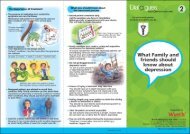

![Invitation Card and Programme Ipoh (English - pdf) [288 Kb]](https://img.yumpu.com/47950469/1/190x67/invitation-card-and-programme-ipoh-english-pdf-288-kb.jpg?quality=85)
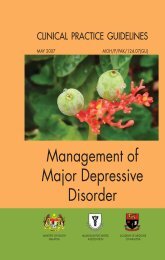
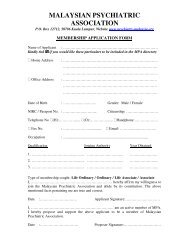
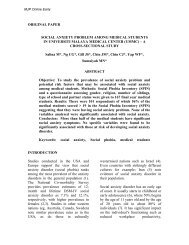
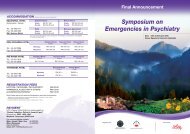

![Invitation Letter to MPA President (English - pdf) [289 Kb]](https://img.yumpu.com/35480253/1/184x260/invitation-letter-to-mpa-president-english-pdf-289-kb.jpg?quality=85)
